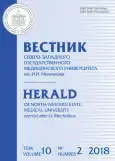Реакция биологических тканей на интракорпорально-полимеризующийся эндопротез для мини-инвазивной пункционно-инфузионной «пломбировки» пахового канала
- Авторы: Трунин Е.М.1, Моулабакас М.Д.1, Мурт Л.Л.1, Смирнов А.А.1, Татаркин В.В.1, Рыбаков В.А.1
-
Учреждения:
- ФГБОУ ВО «Северо-Западный государственный медицинский университет имени И.И. Мечникова» Минздрава России
- Выпуск: Том 10, № 2 (2018)
- Страницы: 99-106
- Раздел: Статьи
- URL: https://journal-vniispk.ru/vszgmu/article/view/9287
- DOI: https://doi.org/10.17816/mechnikov201810299-106
- ID: 9287
Цитировать
Полный текст
Аннотация
Статья посвящена изучению биологических свойств интракорпорально-полимеризующегося эндопротеза, который предназначен для мини-инвазивной пункционно-инфузионной «пломбировки» пахового канала у лиц с вправимой паховой грыжей. Метод предназначен для достижения минимальной инвазивности в области хирургической герниологии. Проведены два экспериментальных исследования с целью изучения реакции живой ткани организма на эндопротез (на крысах) и воздействия эндопротеза на репродуктивную систему кроликов мужского пола.
Полный текст
Открыть статью на сайте журналаОб авторах
Е. М. Трунин
ФГБОУ ВО «Северо-Западный государственный медицинский университет имени И.И. Мечникова» Минздрава России
Автор, ответственный за переписку.
Email: mjaweed10@hotmail.com
кафедра оперативной и клинической хирургии с топографической анатомией
Россия, Санкт-ПетербургМ. Д. Моулабакас
ФГБОУ ВО «Северо-Западный государственный медицинский университет имени И.И. Мечникова» Минздрава России
Email: mjaweed10@hotmail.com
кафедра оперативной и клинической хирургии с топографической анатомией
Россия, Санкт-ПетербургЛ. Л. Мурт
ФГБОУ ВО «Северо-Западный государственный медицинский университет имени И.И. Мечникова» Минздрава России
Email: mjaweed10@hotmail.com
кафедра оперативной и клинической хирургии с топографической анатомией
Россия, Санкт-ПетербургА. А. Смирнов
ФГБОУ ВО «Северо-Западный государственный медицинский университет имени И.И. Мечникова» Минздрава России
Email: mjaweed10@hotmail.com
кафедра оперативной и клинической хирургии с топографической анатомией
Россия, Санкт-ПетербургВ. В. Татаркин
ФГБОУ ВО «Северо-Западный государственный медицинский университет имени И.И. Мечникова» Минздрава России
Email: mjaweed10@hotmail.com
кафедра оперативной и клинической хирургии с топографической анатомией
Россия, Санкт-ПетербургВ. А. Рыбаков
ФГБОУ ВО «Северо-Западный государственный медицинский университет имени И.И. Мечникова» Минздрава России
Email: mjaweed10@hotmail.com
кафедра оперативной и клинической хирургии с топографической анатомией
Россия, Санкт-ПетербургСписок литературы
- Должиков А.А., Колпаков А.Я., Ярош А.Л., и др. Гигантские клетки инородных тел и тканевые реакции на поверхности имплантатов // Курский научно-практический вестник «Человек и его здоровье». - 2017. - Т. 3. - C. 86-94. [Dolzhikov AA, Kolpakov AY, Yarosh AL, et al. Giant foreign body cells and tissue reactions on the surface of implants. Kurskii nauchno-prakticheskii vestnik “Chelovek i ego zdorov’e”. 2017;(3):86-94. (In Russ.)]. doi: 10.21626/vestnik/2017-3/15.
- Жебровский В.В. Общие принципы лечения грыж живота [Электронный ресурс]. URL: http://www.medlinks.ru/article.php. [Zhebrovskiy VV. Obshie principi lechenia grizh zhivota. (In Russ.)]
- Касаткина Т.Б., Капланский А.С. Этика экспериментальных исследований на животных в космической биологии и медицине // Авиакосмическая и экологическая медицина. - 2000. - Т. 34. - № 2. - C. 17-21. [Kasatkina TB, Kaplansky AS. Ethics of space life sciences research with animals. Aviakocmicheskaya i ekologicheskaya meditsina. 2000;34(2):17-21. (In Russ.)]
- Резниченко Н.Ю., Резниченко Ю.Г., Веретельник А.В., и др. Коррекция проявлений физиологического и фотостарения с использованием янтарной кислоты в составе инъекционного имплантата «гиалуаль» // Украинский журнал дерматологии, венерологии, косметологии. - 2010. - № 36 (1). - C. 64-69. [Reznichenko NYu, Reznichenko YuG, Veretelnik AV, et al. The correction of physiologic and photoaging with the use of amber acid in injective implant Hyalual. Ukrainian Journal of Dermatology, Venerology, Cosmetology. 2010;36(1):64-69. (In Russ.)]
- Anderson FA. Amended final report on the safety assessment of polyacrylamide and acrylamide residues in cosmetics. Int J Toxicol. 2005;24Suppl 2:21-50.
- Anderson JM, Rodriguez A, Chang DT. Foreign body reaction to biomaterials. Seminars in Immunology. 2008;20(2):86-100. doi: 10.1016/j.smim.2007.11.004.
- Feldman AT, Wolfe D. Tissue Processing and Hematoxylin and Eosin Staining. In: Day C. (eds) Histopathology. Methods in Molecular Biology (Methods and Protocols). Vol. 1180. New York: Humana Press; 2014.
- Kastellorizios M, Tipnis N, Burgess DJ. Foreign body reaction to subcutaneous implants. Advances in Experimental Medicine and Biology. 2015;865:93-108. doi: 10.1007/978-3-319-18603-0_6.
- Liliana MR, Daniela ED, Eleonora AD. Bioethical dilemmas in using animal in medical research. Challenges and opportunities. Rom J Morphol Embryol. 2015;56(3):1227-1231.
- Punchard NA, Whelan CJ, Adcock I. The Journal of Inflammation. Journal of Inflammation (London, England). 2004;1:1. doi: 10.1186/1476-9255-1-1.
- Til HP, Falke HE, Prinsen MK, Willems MI. Acute and subacute toxicity of tyramine, spermidine, spermine, putrescine and cadaverine in rats. Food and Chemical Toxicology. 1997;3-4(35):337-348.
- Valanzo A. Rules of good practice in the care of laboratory animals used in biomedical research. Ann 1st Super Sanità. 2004;40(2):201-203.
Дополнительные файлы


























